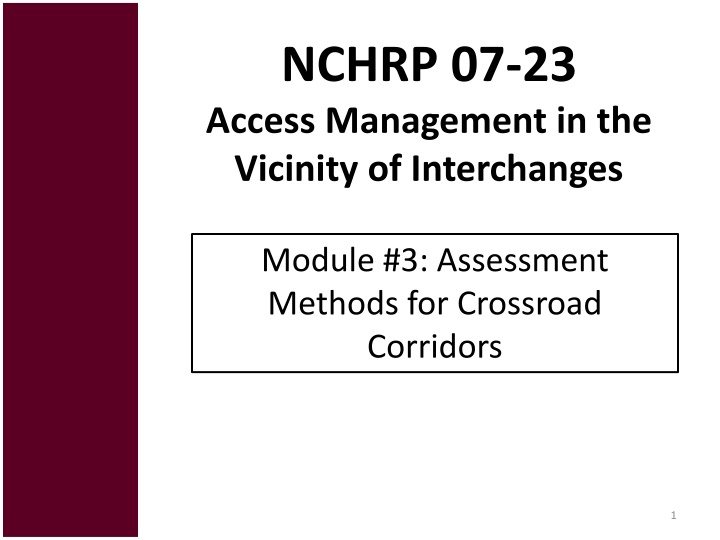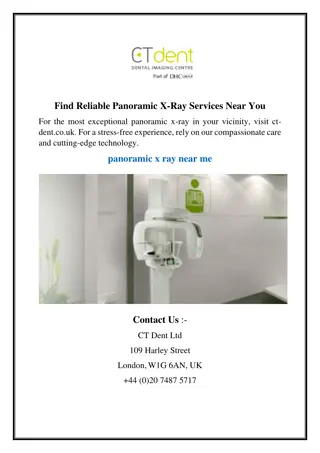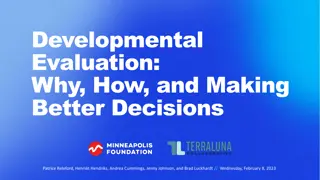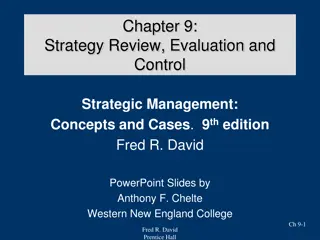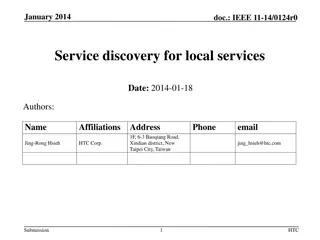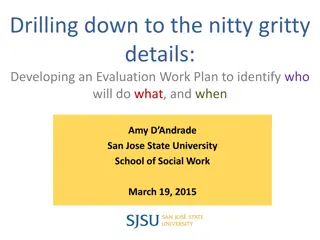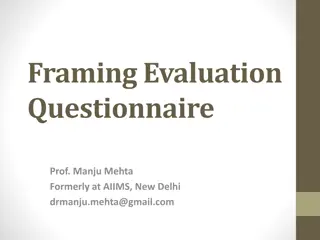Evaluation and Analysis Methods for Interchange Vicinity Management
Assessment methods, performance measures, and observations related to operational and safety performance at signalized and STOP-controlled diamond interchanges are discussed in this detailed document. The impact of various factors on average operating speeds, access points, and distance to intersections is analyzed, providing insights into managing crossroad corridors effectively.
Download Presentation

Please find below an Image/Link to download the presentation.
The content on the website is provided AS IS for your information and personal use only. It may not be sold, licensed, or shared on other websites without obtaining consent from the author.If you encounter any issues during the download, it is possible that the publisher has removed the file from their server.
You are allowed to download the files provided on this website for personal or commercial use, subject to the condition that they are used lawfully. All files are the property of their respective owners.
The content on the website is provided AS IS for your information and personal use only. It may not be sold, licensed, or shared on other websites without obtaining consent from the author.
E N D
Presentation Transcript
NCHRP 07-23 Access Management in the Vicinity of Interchanges Module #3: Assessment Methods for Crossroad Corridors 1
Types of Evaluations Operational Performance Qualitative Quantitative Safety Performance Qualitative Quantitative 2
Performance Measures for Operational Analysis Average operating speed in mph for both directions of travel (ASBD). Average operating speed in mph for vehicles traveling away from interchange (ASAFI). Average operating speed in mph for vehicles traveling toward the interchange (ASTI). 3
Operations at Signalized Diamonds Distance to Upstream Driveway Distance to Signal Distance to Downstream Driveway Posted Speed Limit Access Density Median Type Speed Volume Signalized Diamond Interchange without Channelized Right Turns Signalized Diamond Interchange with Channelized Right Turns Note: Symbols used in this table represent the following: = Statistically significant (at =0.05) increase in speed with increased level of the variable = Statistically insignificant influence on speed = Statistically significant decrease in speed with increased level of the variable N/A = Not applicable Both Away Towards Varies Both Away Towards 4
Summary of Observations (Signal) As the hourly crossroad traffic volume increases, the operating speeds decrease. As the distance to the downstream signalized intersection increases, the operating speeds also increase. One exception to this observation is a reduction in the average operating speed away from the terminal intersection when channelized right turns are provided. This reduction is minimal (less than 2 mph). As the number of access points per mile intersecting the crossroad increases, the average operating speed for both directions of travel decreases. The influence on the average operating speed varies when considering the influence of the distance to the closest upstream driveway, median type, and posted speed limit. In all cases, the distance to the closest downstream driveway has an insignificant influence on the average operating speed for signalized diamond interchanges. 5
Operations at STOP-Controlled Diamonds Distance to Upstream Driveway Distance to Signal Distance to Downstream Driveway Posted Speed Limit Access Density Median Type Speed Volume STOP Controlled Diamond Interchange N/A N/A N/A Both Away Towards Note: Symbols used in this table represent the following: = Statistically significant (at =0.05) increase in speed with increased level of the variable = Statistically insignificant influence on speed = Statistically significant decrease in speed with increased level of the variable N/A = Not applicable 6
Summary of Observations (STOP) As the hourly crossroad traffic volume increases, the operating speeds decrease. As the number of access points per mile intersecting the crossroad increases, the average operating speed decreases. As the distance to the closest downstream driveway increases, the average operating speed similarly increases. As the posted speed limit increases, the average operating speed also increases. The distance to the closest upstream driveway and the median type each has an insignificant influence on the average operating speed for STOP-controlled diamond interchanges. 7
Operations at PARCLOs Distance to Upstream Driveway Distance to Signal Distance to Downstream Driveway Posted Speed Limit Access Density Median Type Speed Volume PARCLO Interchange (N=176) Both Away Towards Note: Symbols used in this table represent the following: = Statistically significant (at =0.05) increase in speed with increased level of the variable = Statistically insignificant influence on speed = Statistically significant decrease in speed with increased level of the variable N/A = Not applicable Varies Varies 8
Summary of Observations (PARCLO) As the hourly crossroad traffic volume increases, the operating speeds decrease. As the distance to the closest signalized intersection increases, the average speed for both directions increases. The speed also increases for vehicles travelling away from the interchange. The location of the signalized intersection has little to no influence on the average operating speed of vehicles approaching the interchange. As the number of access points per mile intersecting the crossroad increases, the average operating speed decreases for vehicles approaching the interchange. There is not a notable influence for vehicles traveling away from the interchange. 9
Summary of Observations (PARCLO) - - Continued As the distance to the closest downstream driveway increases, the average operating speed away from the interchange decreases by up to one mph. Alternatively, the average operating speed towards the interchange increases by up to one mph. This results in an insignificant influence on operating speed for both directions of travel. The median configuration has varying influences on the operating speed. The average operating speed for vehicles approaching the interchange increases for raised continuous medians and decreases for strategically positioned medians or TWLTL configurations. The median has little influence on the operating speed for vehicles traveling away from the interchange. The distance to the closest upstream driveway as well as the speed limit each have little influence on the crossroad operating speeds in the vicinity of PARCLOs. 10
Operations at SPUIs Distance to Upstream Driveway Distance to Signal Distance to Downstream Driveway Posted Speed Limit Access Density Median Type Speed Volume SPUI Interchanges Both Away Towards Note: Symbols used in this table represent the following: = Statistically significant (at =0.05) increase in speed with increased level of the variable = Statistically insignificant influence on speed = Statistically significant decrease in speed with increased level of the variable N/A = Not applicable Varies 11
Summary of Observations (SPUI) As the hourly crossroad traffic volume increases, the operating speeds decrease. As the distance to the closest signalized intersection increases, the average speed for both directions increases. The speed also increases for vehicles travelling toward the interchange. A reduction in up to one mph can be expected for the average speed of vehicles traveling away from the interchange. As the number of access points per mile intersecting the crossroad increases, the average operating speed decreases for vehicles travelling away from the interchange. There is not a notable influence for vehicles traveling toward the interchange. 12
Summary of Observations (SPUI) - Continued As the distance to the closest downstream driveway increases, the average operating speeds also increase. The median configuration has varying influences on the operating speed. The average operating speed for vehicles approaching the interchange decreases for raised continuous medians and increases for strategically positioned medians or TWLTL configurations. Notably, these values influence the speed by less than one mph and may be considered inconsequential in the analysis. The median configuration has little influence on the operating speed for vehicles traveling away from the interchange. The distance to the closest upstream driveway as well as the speed limit have little influence on the crossroad operating speeds in the vicinity of SPUIs. 13
Operational Overview of Speed Influences Distance to Downstream Driveway Distance to Upstream Driveway Posted Speed Limit Interchange Configuration Distance to Signal Access Density Median Type Volume Values shown below represent the average speed for both directions of travel Signalized Diamond (no channelized right-turns) X X X X Signalized Diamond (with channelized right-turns) X X X STOP Controlled Diamond X X X X PARCLO X X X SPUI X X X X 14
Quantitative Safety Assessment AASHTO s Highway Safety Manual provides tools to assess safety. Where possible, the safety performance function in the Manual should be calibrated for local conditions. 15
End of Module #3 Operational and safety assessments, both qualitative and quantitative, provide valuable information. Module #4 demonstrates example case studies. 16
